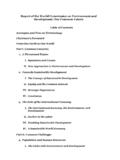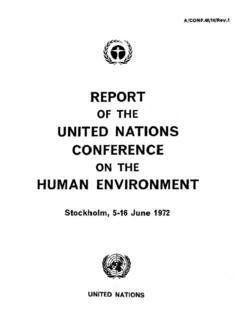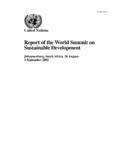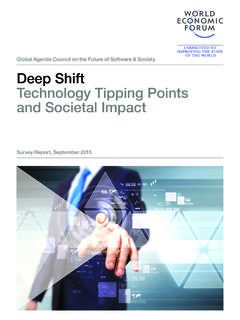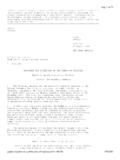Transcription of Many Voices One World - UN Documents
1 Communication and SocietyToday and TomorrowMany VoicesOne WorldTowards a newmore just and more efficientworld information and communication orderReport by the International Commissionfor the Study of Communication ProblemsFirst published in 1980 and reprinted 1981by the United NationsEducational, Scientific and Cultural OrganizationPlace de Fontenoy, Parisand Kogan Page Ltd120 Pentonville Road, Londonand Unipub345 Park Avenue SouthNew York Unesco, 1980 Printed by The Anchor Press Ltd and bound by Wm Brendon & Son Ltdboth of Tiptree, Colchester, EssexISBN 0 85038 348 X (Kogan Page)ISBN 0 89059-008-7 (Unipub) ISBN 0 92-3-101802-7 (Unesco) The opinions expressed in this work are those of the International Commission for theStudy of Communication Problems or, where indicated, of one of its members and are notnecessarily those of Unesco.
2 The designations employed and the presentation of thematerial in this work do not imply the expression of any opinion whatsoever on the partof the Unesco Secretariat concerning the legal status of any country or territory, or of itsauthorities, or concerning the delimitations of the frontiers of any country or edition published by Information Habitat: Where Information Lives based on OpticalCharacter Recognition of a scanned copy of the original report available from Unesco Members of the Commission Sean MacBride (Ireland), President Elie Abel (USA) Hubert Beuve-Mery (France) Elebe Ma Ekonzo (Zaire) Gabriel Garcia Marquez (Colombia) Sergei Losev (USSR) Mochtar Lubis (Indonesia) Mustapha Masmoudi (Tunisia) Michio Nagai (Japan) Fred Isaac Akporuaro Omu (Nigeria)Bogdan Osolnik (Yugoslavia) Gamal EI Oteifi (Egypt) Johannes Pieter Pronk (Netherlands) Juan Somavia (Chile) Boobli George Verghese (India) Betty Zimmerman (Canada) Secretariat Members: Asher Deleon (Executive Secretary), Pierre Henquet, Ahmed Kettani,John G.
3 Massee, William Syad, Suzanne Do Dinh, Daphne Mullett,Sheila de Vallee, Jane Wright Collaborating Consultants: Francis Balle, James Halloran, John Lee, FernandoReyes Matta, Mrs Deba Wieland, Yassen Zassoursky Editorial Advisor to the President: Mervyn Jones Translators: John Crombie, Gilles Philibert Table of ContentsPart and SocietyChapter Historical Past Still Roots of the Future in the MakingChapter Contemporary Functions of Social Political Economic Educational Impulse and Threat to Technological DilemmaChapter International and International forum open to the World : UnescoNotesPart TodayChapter of and and and and Local Mass Libraries to Data of Telephone for Specialised and and Television and Towards New AreasChapter : Changing of Traditional and between Interpersonal and Mediated of Visual Efforts for News Messages to Diverse of New TechnologiesChapter Communication in Ownership and and : and Voluntary and Transnational BodiesChapter between Developed and Developing Less Quantitative DisparitiesNotesPart and Issues of Common ConcernChapter in Communication DominanceChapter in Communication of responsibilitiesChapter of to in the Right to CommunicateChapter of the and and Gap both Old and New.
4 The North-South of Human Rights for and CooperationChapter Public and Public Concept of the Public Public the Concepts of the Public and of Public OpinionNotesPart Institutional and Professional FrameworkChapter with Development Institutional Structural FrameworkChapter of Communications Cooperation and Foreign AssistanceChapter Trends in Communications and NeedsChapter Professional of in of ProfessionalsChapter and Responsibilities of to of Rights and the General InterestChapter of Professional of Professional and Media of Reply and Right of CorrectionNotesPart V Communication and Independence and Self-relianceCommunication PoliciesStrengthening CapacitiesBasic NeedsParticular ChallengesII. Social Consequences and New TasksIntegrating Communication into DevelopmentFacing the Technological ChallengeStrengthening Cultural IdentityReducing the Commercialization of CommunicationAccess to Technical InformationIII.
5 Professional Integrity and StandardsResponsibility of JournalistsTowards Improved International ReportingProtection of JournalistsIV. Democratization of CommunicationHuman RightsRemoval of ObstaclesDiversity and ChoiceIntegration and ParticipationV. Fostering International CooperationPartners for DevelopmentStrengthening Collective Self-relianceInternational MechanismsTowards International UnderstandingB. Issues Requiring Further Standards and and Dissemination of of Attention to Neglected Extensive Financial ResourcesNotesMany Voices , One World . Part I. Communication and society I-1 many Voices , One WorldTowards a new more just and more efficient World information and communication orderReport by the Commission for the Study of Communications ProblemsPart I. Communication and SocietyChapter 1.
6 The Historical Dimension1. A Past Still Present2. The Roots of the Present3. The Future in the MakingChapter 2. The Contemporary Dimension1. The Functions of Communication2. A Social Need3. A Political Instrument4. An Economic Force5. An Educational Potential6. An Impulse and Threat to Culture7. The Technological DilemmaChapter 3. The International Dimension1. The Issue2. Imbalances and Inequalities3. The International Debate4. A forum open to the World : UnescoNotesMany Voices , One World . Part I. Communication and society I-2 Part ICommunication and SocietyChapter 1 The Historical DimensionCommunication maintains and animates life. It is also the motor and expression of social activityand civilization; it leads people and peoples from instinct to inspiration, through variegatedprocesses and systems of enquiry, command and control; it creates a common pool of ideas,strengthens the feeling of togetherness through exchange of messages and translates thought intoaction, reflecting every emotion and need from the humblest tasks of human survival to suprememanifestations of creativity - or destruction.
7 Communication integrates knowledge, organizationand power and runs as a thread linking the earliest memory of man to his noblest aspirationsthrough constant striving for a better life. As the World has advanced, the task of communicationhas become ever more complex and subtle - to contribute to the liberation of mankind fromwant, oppression and fear and to unite it in community and communion, solidarity andunderstanding. However, unless some basic structural changes are introduced, the potentialbenefits of technological and communication development will hardly be put at the disposal ofthe majority of A Past Still PresentGenerously endowed with diverse innate faculties for communication, mankind owes its successas a species both to its organizational capacity and to the capacity it has displayed for improving,developing and extending these natural gifts, thereby influencing its own biological of man's earliest preoccupations has been to increase the impact, diversity and intelligibilityof his messages while simultaneously developing his capacity to intercept and decipher history.
8 Human beings have sought to improve their ability to receive and assimilateinformation about their surroundings and at the same time to increase the speed, clarity andvariety of their own methods for transmission of information. This was necessary first to createawareness of dangers that might be lurking and then to share a vision of the social possibilities ofmeeting those with the simplest vocal and gestural signals rooted in their physical structure, humanbeings developed a whole range of non-verbal means for conveying messages: music and dance,drum messages, signal fires, drawings and other forms of graphic symbols, including thepictogram, followed by the ideogram, important especially because it associated therepresentation of an object with an abstract idea. But what rendered human communicationparticularly powerful, and gave Mankind its pre-eminent position in the animal World , was thedevelopment of language, important for the potential scope and depth it gave to the content ofcommunication, as well as for the precision and detail of expression it allowed.
9 All these meansand ways of communication were simultaneously in use, indispensable to the survival ofindividuals who were organizing themselves into societies of different sorts and therefore requiredboth interpersonal and intercommunal methods for exchanging is, in fact, virtually no limit to the variety and the ingenuity of the modes ofcommunication employed by human beings. The forms and content of communication developedand varied continuously. Different languages arose because of lack of contact among peoples ofdistant regions, but especially because societies with distinct economic, moral and culturaltraditions required specific vocabularies and linguistic structures. But at the same time, evenwithin communities, distinctions between social groups - especially between a dominant elite andMany Voices , One World .
10 Part I. Communication and society I-3the mass of the population - came to be reflected in differences in idiom and vocabulary, in themeaning given to certain words, as well as in pronunciation. Millions of people today speaklanguages that are not understood by neighbouring groups, even though close social andeconomic links have been established and populations have intermingled. Thus, paradoxically,the very richness and diversity of languages can render communication difficult, just as itselaboration can perpetuate languages came to acquire a special status introduced by religious leaders, scholars orconquerors, sometimes becoming the basis of power and privilege. A language spoken by a smallminority - such as Sanskrit in India or Latin in medieval Europe - could become the medium ofscholarship, of record-keeping and of religious ceremony.
